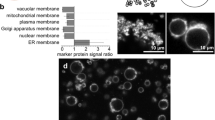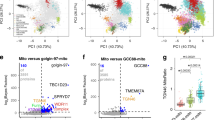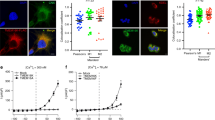Abstract
This article describes a procedure to prepare a raft-like intracellular membrane fraction enriched for the trans-Golgi network (TGN) and endosomal compartments. The initial step in this technique involves cell disruption by homogenization, followed by clearance of the plasma membrane, late endosomes, mitochondria and the endoplasmic reticulum by differential sedimentation. Carbonate treatment, sonication and sucrose density-gradient ultracentrifugation are subsequently used to isolate the target membranes. The isolated subcellular fraction contains less than 1% of the total cellular proteins, but it is highly enriched for syntaxin-6 and Rab11. Typically, 40–60% of the cellular pool of GM1 glycosphingolipid and 10–20% of the total cellular cholesterol cofractionate with this buoyant membrane fraction. Given the role of GM1 as a cell-surface receptor for the cholera toxin and that levels of both GM1 and cholesterol in the TGN-endosomal compartment are upregulated in some inherited diseases, this protocol can potentially be applied to the analysis of disease-associated changes to GM1-enriched intracellular membranes. The isolated membranes are very well separated from caveolin-rich domains of the plasma membrane, the TGN and recycling endosomes. The entire protocol can be completed in as little as 1 d.
This is a preview of subscription content, access via your institution
Access options
Subscribe to this journal
Receive 12 print issues and online access
$259.00 per year
only $21.58 per issue
Buy this article
- Purchase on Springer Link
- Instant access to full article PDF
Prices may be subject to local taxes which are calculated during checkout




Similar content being viewed by others
References
Waugh, M.G., Chu, K.M., Clayton, E.L., Minogue, S. & Hsuan, J.J. Detergent-free isolation and characterization of cholesterol-rich membrane domains from trans-Golgi network vesicles. J. Lipid Res. 52, 582–589 (2011).
Dupree, P., Parton, R.G., Raposo, G., Kurzchalia, T.V. & Simons, K. Caveolae and sorting in the trans-Golgi network of epithelial cells. EMBO J. 12, 1597–1605 (1993).
Pulvirenti, T. et al. A traffic-activated Golgi-based signalling circuit coordinates the secretory pathway. Nat. Cell Biol. 10, 912–922 (2008).
Anitei, M. et al. Protein complexes containing CYFIP/Sra/PIR121 coordinate Arf1 and Rac1 signalling during clathrin-AP-1-coated carrier biogenesis at the TGN. Nat. Cell Biol. 12, 330–340 (2010).
De Matteis, M.A. & Luini, A. Exiting the Golgi complex. Nat. Rev. Mol. Cell Biol. 9, 273–284 (2008).
Choudhury, A. et al. Rab proteins mediate Golgi transport of caveola-internalized glycosphingolipids and correct lipid trafficking in Niemann-Pick C cells. J. Clin. Invest. 109, 1541–1550 (2002).
Gokool, S., Tattersall, D. & Seaman, M.N. EHD1 interacts with retromer to stabilize SNX1 tubules and facilitate endosome-to-Golgi retrieval. Traffic 8, 1873–1886 (2007).
Iversen, T.G. et al. Endosome to Golgi transport of ricin is independent of clathrin and of the Rab9- and Rab11-GTPases. Mol. Biol. Cell 12, 2099–20107 (2001).
Pike, L.J., Han, X., Chung, K.N. & Gross, R.W. Lipid rafts are enriched in arachidonic acid and plasmenylethanolamine and their composition is independent of caveolin-1 expression: a quantitative electrospray ionization/mass spectrometric analysis. Biochemistry 41, 2075–2088 (2002).
Zacharias, D.A., Violin, J.D., Newton, A.C. & Tsien, R.Y. Partitioning of lipid-modified monomeric GFPs into membrane microdomains of live cells. Science 296, 913–916 (2002).
Khosravi-Far, R. et al. Isoprenoid modification of rab proteins terminating in CC or CXC motifs. Proc. Natl. Acad. Sci. USA 88, 6264–6268 (1991).
Klotzsch, E. & Schutz, G.J. A critical survey of methods to detect plasma membrane rafts. Philos. Trans. R. Soc. Lond. B Biol. Sci. 368, 20120033 (2013).
Sonnino, S. & Prinetti, A. Membrane domains and the 'lipid raft' concept. Curr. Med. Chem. 20, 4–21 (2013).
Reeves, V.L., Thomas, C.M. & Smart, E.J. Lipid rafts, caveolae and GPI-linked proteins. Adv. Exp. Med. Biol. 729, 3–13 (2012).
Bock, J.B., Klumperman, J., Davanger, S. & Scheller, R.H. Syntaxin 6 functions in trans-Golgi network vesicle trafficking. Mol. Biol. Cell 8, 1261–1271 (1997).
Kuliawat, R. et al. Syntaxin-6 SNARE involvement in secretory and endocytic pathways of cultured pancreatic beta cells. Mol. Biol. Cell 15, 1690–1701 (2004).
Wang, Y.J. et al. Phosphatidylinositol 4 phosphate regulates targeting of clathrin adaptor AP-1 complexes to the Golgi. Cell 114, 299–310 (2003).
Simonsen, A., Gaullier, J.M., D'Arrigo, A. & Stenmark, H. The Rab5 effector EEA1 interacts directly with syntaxin-6. J. Biol. Chem. 274, 28857–28860 (1999).
Balla, A., Tuymetova, G., Barshishat, M., Geiszt, M. & Balla, T. Characterization of type II phosphatidylinositol 4-kinase isoforms reveals association of the enzymes with endosomal vesicular compartments. J. Biol. Chem. 277, 20041–20050 (2002).
Minogue, S. et al. Phosphatidylinositol 4-kinase is required for endosomal trafficking and degradation of the EGF receptor. J. Cell Sci. 119, 571–581 (2006).
Waugh, M.G. et al. Localization of a highly active pool of type II phosphatidylinositol 4-kinase in a p97/valosin-containing-protein-rich fraction of the endoplasmic reticulum. Biochem. J. 373, 57–63 (2003).
Chen, W., Feng, Y., Chen, D. & Wandinger-Ness, A. Rab11 is required for trans-Golgi network-to-plasma membrane transport and a preferential target for GDP dissociation inhibitor. Mol. Biol. Cell 9, 3241–3257 (1998).
Ishida-Yamamoto, A., Kishibe, M., Takahashi, H. & Iizuka, H. Rab11 is associated with epidermal lamellar granules. J. Invest. Dermatol. 127, 2166–2170 (2007).
Ullrich, O., Reinsch, S., Urbe, S., Zerial, M. & Parton, R.G. Rab11 regulates recycling through the pericentriolar recycling endosome. J. Cell Biol. 135, 913–924 (1996).
Urbe, S., Huber, L.A., Zerial, M., Tooze, S.A. & Parton, R.G. Rab11, a small GTPase associated with both constitutive and regulated secretory pathways in PC12 cells. FEBS Lett. 334, 175–182 (1993).
Wilcke, M. et al. Rab11 regulates the compartmentalization of early endosomes required for efficient transport from early endosomes to the trans-Golgi network. J. Cell Biol. 151, 1207–1220 (2000).
Xu, H. et al. The asymmetrical structure of Golgi apparatus membranes revealed by in situ atomic force microscope. PLoS ONE 8, e61596 (2013).
Minogue, S. et al. Relationship between phosphatidylinositol 4-phosphate synthesis, membrane organization, and lateral diffusion of PI4KIIα at the trans-Golgi network. J. Lipid Res. 51, 2314–2324 (2010).
Waugh, M.G., Minogue, S., Chotai, D., Berditchevski, F. & Hsuan, J.J. Lipid and peptide control of phosphatidylinositol 4-kinase IIα activity on Golgi-endosomal rafts. J. Biol. Chem. 281, 3757–3763 (2006).
Banerji, S. et al. Oxysterol binding protein-dependent activation of sphingomyelin synthesis in the Golgi apparatus requires phosphatidylinositol 4-kinase IIα. Mol. Biol. Cell 21, 4141–4150 (2010).
Lu, D. et al. Phosphatidylinositol 4-kinase IIα is palmitoylated by Golgi-localized palmitoyltransferases in cholesterol-dependent manner. J. Biol. Chem. 287, 21856–21865 (2012).
Chang, J.C. & Rosenthal, S.J. Visualization of lipid raft membrane compartmentalization in living RN46A neuronal cells using single quantum-dot tracking. ACS Chem. Neurosci. 3, 737–743 (2012).
Mori, K., Mahmood, M.I., Neya, S., Matsuzaki, K. & Hoshino, T. Formation of GM1 ganglioside clusters on the lipid membrane containing sphingomyeline and cholesterol. J. Phys. Chem. B 116, 5111–5121 (2012).
Fujita, A., Cheng, J. & Fujimoto, T. Segregation of GM1 and GM3 clusters in the cell membrane depends on the intact actin cytoskeleton. Biochim. Biophys. Acta 1791, 388–396 (2009).
Fujita, A. et al. Gangliosides GM1 and GM3 in the living cell membrane form clusters susceptible to cholesterol depletion and chilling. Mol. Biol. Cell 18, 2112–2122 (2007).
Chinnapen, D.J. et al. Lipid sorting by ceramide structure from plasma membrane to ER for the cholera toxin receptor ganglioside GM1. Dev. Cell 23, 573–586 (2013).
Jobling, M.G., Yang, Z., Kam, W.R., Lencer, W.I. & Holmes, R.K. A single native ganglioside GM1-binding site is sufficient for cholera toxin to bind to cells and complete the intoxication pathway. MBio 3, e00401–e00412 (2012).
Gulati, S., Liu, Y., Munkacsi, A.B., Wilcox, L. & Sturley, S.L. Sterols and sphingolipids: dynamic duo or partners in crime? Prog. Lipid. Res. 49, 353–365 (2010).
Holtta-Vuori, M., Tanhuanpaa, K., Mobius, W., Somerharju, P. & Ikonen, E. Modulation of cellular cholesterol transport and homeostasis by Rab11. Mol. Biol. Cell 13, 3107–3122 (2002).
Rosenbaum, A.I., Zhang, G., Warren, J.D. & Maxfield, F.R. Endocytosis of β-cyclodextrins is responsible for cholesterol reduction in Niemann-Pick type C mutant cells. Proc. Natl. Acad. Sci. USA 107, 5477–5482 (2010).
Vance, J.E. Lipid imbalance in the neurological disorder, Niemann-Pick C disease. FEBS Lett. 580, 5518–5524 (2006).
Erickson, R.P. Current controversies in Niemann-Pick C1 disease: steroids or gangliosides; neurons or neurons and glia. J. Appl. Genet. 54, 215–224 (2013).
Schneider, J.S. et al. A randomized, controlled, delayed start trial of GM1 ganglioside in treated Parkinson's disease patients. J. Neurol. Sci. 324, 140–148 (2013).
Schneider, J.S., Sendek, S., Daskalakis, C. & Cambi, F. GM1 ganglioside in Parkinson's disease: results of a five year open study. J. Neurol. Sci. 292, 45–51 (2010).
Vetrivel, K.S. & Thinakaran, G. Membrane rafts in Alzheimer's disease β-amyloid production. Biochim. Biophys. Acta 1801, 860–867 (2010).
Rajendran, L. et al. Efficient inhibition of the Alzheimer's disease β-secretase by membrane targeting. Science 320, 520–523 (2008).
Vetrivel, K.S. et al. Association of γ-secretase with lipid rafts in post-Golgi and endosome membranes. J. Biol. Chem. 279, 44945–44954 (2004).
Schnitzer, J.E., McIntosh, D.P., Dvorak, A.M., Liu, J. & Oh, P. Separation of caveolae from associated microdomains of GPI-anchored proteins. Science 269, 1435–1439 (1995).
Schnitzer, J.E., Oh, P., Jacobson, B.S. & Dvorak, A.M. Caveolae from luminal plasmalemma of rat lung endothelium: microdomains enriched in caveolin, Ca2+-ATPase, and inositol trisphosphate receptor. Proc. Natl. Acad. Sci. USA 92, 1759–1763 (1995).
Smart, E.J., Ying, Y.S., Mineo, C. & Anderson, R.G. A detergent-free method for purifying caveolae membrane from tissue culture cells. Proc. Natl. Acad. Sci. USA 92, 10104–10108 (1995).
Song, K.S. et al. Co-purification and direct interaction of Ras with caveolin, an integral membrane protein of caveolae microdomains. Detergent-free purification of caveolae microdomains. J. Biol. Chem. 271, 9690–9697 (1996).
Stan, R.V. et al. Immunoisolation and partial characterization of endothelial plasmalemmal vesicles (caveolae). Mol. Biol. Cell 8, 595–605 (1997).
Macdonald, J.L. & Pike, L.J. A simplified method for the preparation of detergent-free lipid rafts. J. Lipid. Res. 46, 1061–1067 (2005).
Waugh, M.G. & Hsuan, J.J. Preparation of membrane rafts. Methods Mol. Biol. 462, 403–414 (2009).
Lingwood, D. & Simons, K. Detergent resistance as a tool in membrane research. Nat. Protoc. 2, 2159–2165 (2007).
Mukherjee, S., Zha, X., Tabas, I. & Maxfield, F.R. Cholesterol distribution in living cells: fluorescence imaging using dehydroergosterol as a fluorescent cholesterol analog. Biophys. J. 75, 1915–1925 (1998).
Klemm, R.W. et al. Segregation of sphingolipids and sterols during formation of secretory vesicles at the trans-Golgi network. J. Cell Biol. 185, 601–612 (2009).
Dhanvantari, S. & Loh, Y.P. Lipid raft association of carboxypeptidase E is necessary for its function as a regulated secretory pathway sorting receptor. J. Biol. Chem. 275, 29887–29893 (2000).
Keller, P. & Simons, K. Cholesterol is required for surface transport of influenza virus hemagglutinin. J. Cell Biol. 140, 1357–1367 (1998).
Ying, M., Grimmer, S., Iversen, T.G., Van Deurs, B. & Sandvig, K. Cholesterol loading induces a block in the exit of VSVG from the TGN. Traffic 4, 772–784 (2003).
Waugh, M.G., Lawson, D., Tan, S.K. & Hsuan, J.J. Phosphatidylinositol 4-phosphate synthesis in immunoisolated caveolae-like vesicles and low buoyant density non-caveolar membranes. J. Biol. Chem. 273, 17115–17121 (1998).
Weixel, K.M., Blumental-Perry, A., Watkins, S.C., Aridor, M. & Weisz, O.A. Distinct Golgi populations of phosphatidylinositol 4-phosphate regulated by phosphatidylinositol 4-kinases. J. Biol. Chem. 280, 10501–10508 (2005).
Clayton, E.L., Minogue, S. & Waugh, M.G. Phosphatidylinositol 4-kinases and PI4P metabolism in the nervous system: roles in psychiatric and neurological diseases. Mol. Neurobiol. 47, 361–372 (2013).
Watson, R.T. & Pessin, J.E. Functional cooperation of two independent targeting domains in syntaxin 6 is required for its efficient localization in the trans-Golgi network of 3T3L1 adipocytes. J. Biol. Chem. 275, 1261–1268 (2000).
de Graaf, P. et al. Phosphatidylinositol 4-kinaseβ is critical for functional association of rab11 with the Golgi complex. Mol. Biol. Cell 15, 2038–2047 (2004).
Craige, B., Salazar, G. & Faundez, V. Phosphatidylinositol-4-kinase type II α contains an AP-3 sorting motif and a kinase domain that are both required for endosome traffic. Mol. Biol. Cell 19, 1415–1426 (2008).
Waugh, M.G., Minogue, S., Anderson, J.S., dos Santos, M. & Hsuan, J.J. Signalling and non-caveolar rafts. Biochem. Soc. Trans. 29, 509–511 (2001).
Waugh, M.G., Minogue, S., Blumenkrantz, D., Anderson, J.S. & Hsuan, J.J. Identification and characterization of differentially active pools of type IIα phosphatidylinositol 4-kinase activity in unstimulated A431 cells. Biochem. J. 376, 497–503 (2003).
Barylko, B. et al. Palmitoylation controls the catalytic activity and subcellular distribution of phosphatidylinositol 4-kinase IIα. J. Biol. Chem. 284, 9994–10003 (2009).
Moreno-Smith, M. et al. ATP11B mediates platinum resistance in ovarian cancer. J. Clin. Invest. 123, 2119–2130 (2013).
Cunningham, M.R., Nisar, S.P., Cooke, A.E., Emery, E.D. & Mundell, S.J. Differential endosomal sorting of a novel P2Y12 purinoreceptor mutant. Traffic 14, 585–598 (2013).
Waugh, M.G., Minogue, S., Clayton, E.L. & Hsuan, J.J. CDP-diacylglycerol phospholipid synthesis in detergent-soluble, non-raft, membrane microdomains of the endoplasmic reticulum. J. Lipid Res. 52, 2148–2158 (2011).
Minogue, S. & Waugh, M.G. Lipid rafts, microdomain heterogeneity and inter-organelle contacts: impacts on membrane preparation for proteomic studies. Biol. Cell 104, 618–627 (2012).
Chamberlain, L.H. Detergents as tools for the purification and classification of lipid rafts. FEBS Lett. 559, 1–5 (2004).
Owen, D.M., Magenau, A., Williamson, D. & Gaus, K. The lipid raft hypothesis revisited—new insights on raft composition and function from super-resolution fluorescence microscopy. Bioessays 34, 739–747 (2012).
Suzuki, K.G. Lipid rafts generate digital-like signal transduction in cell plasma membranes. Biotechnol. J. 7, 753–761 (2012).
Larocca, T.J. et al. Proving lipid rafts exist: membrane domains in the prokaryote Borrelia burgdorferi have the same properties as eukaryotic lipid rafts. PLoS Pathog. 9, e1003353 (2013).
Soula, H.A., Coulon, A. & Beslon, G. Membrane microdomains emergence through non-homogeneous diffusion. BMC Biophys. 5, 6 (2012).
Sobo, K., Chevallier, J., Parton, R.G., Gruenberg, J. & van der Goot, F.G. Diversity of raft-like domains in late endosomes. PLoS ONE 2, e391 (2007).
Williamson, R. et al. Isolation of detergent resistant microdomains from cultured neurons: detergent dependent alterations in protein composition. BMC Neurosci. 11, 120 (2010).
Schuck, S., Honsho, M., Ekroos, K., Shevchenko, A. & Simons, K. Resistance of cell membranes to different detergents. Proc. Natl. Acad. Sci. USA 100, 5795–5800 (2003).
Dawson, R.M.C., Elliot, D.C., Elliot, W.H. & Jones, K.M. Data for Biochemical Research (Oxford Science Publications, 1986).
Bradford, M.M. A rapid and sensitive method for the quantitation of microgram quantities of protein utilizing the principle of protein-dye binding. Anal. Biochem. 72, 248–254 (1976).
Panfoli, I. et al. A blue dive: from 'blue fingers' to 'blue silver'. A comparative overview of staining methods for in-gel proteomics. Expert Rev. Proteomics 9, 627–634 (2012).
Kim, C.S., Seo, J.H. & Cha, H.J. Functional interaction analysis of GM1-related carbohydrates and Vibrio cholerae toxins using carbohydrate microarray. Anal. Chem. 84, 6884–6890 (2012).
Lauer, S., Goldstein, B., Nolan, R.L. & Nolan, J.P. Analysis of cholera toxin-ganglioside interactions by flow cytometry. Biochemistry 41, 1742–1751 (2002).
MacKenzie, C.R., Hirama, T., Lee, K.K., Altman, E. & Young, N.M. Quantitative analysis of bacterial toxin affinity and specificity for glycolipid receptors by surface plasmon resonance. J. Biol. Chem. 272, 5533–5538 (1997).
Kuziemko, G.M., Stroh, M. & Stevens, R.C. Cholera toxin binding affinity and specificity for gangliosides determined by surface plasmon resonance. Biochemistry 35, 6375–6384 (1996).
Levery, S.B. Glycosphingolipid structural analysis and glycosphingolipidomics. Methods Enzymol. 405, 300–369 (2005).
Nakamura, N. et al. Characterization of a cis-Golgi matrix protein, GM130. J. Cell Biol. 131, 1715–1726 (1995).
Pan, S. et al. Golgi localization of ERManI defines spatial separation of the mammalian glycoprotein quality control system. Mol. Biol. Cell 22, 2810–2822 (2011).
Parton, R.G. Ultrastructural localization of gangliosides; GM1 is concentrated in caveolae. J. Histochem. Cytochem. 42, 155–166 (1994).
Patki, V. et al. Identification of an early endosomal protein regulated by phosphatidylinositol 3-kinase. Proc. Natl. Acad. Sci. USA 94, 7326–7330 (1997).
Schneider, C.A., Rasband, W.S. & Eliceiri, K.W. NIH Image to ImageJ: 25 years of image analysis. Nat. Methods 9, 671–675 (2012).
Ikonen, E., Fiedler, K., Parton, R.G. & Simons, K. Prohibitin, an antiproliferative protein, is localized to mitochondria. FEBS Lett. 358, 273–277 (1995).
Ahluwalia, N., Bergeron, J.J., Wada, I., Degen, E. & Williams, D.B. The p88 molecular chaperone is identical to the endoplasmic reticulum membrane protein, calnexin. J. Biol. Chem. 267, 10914–10918 (1992).
Fujita, H., Tuma, P.L., Finnegan, C.M., Locco, L. & Hubbard, A.L. Endogenous syntaxins 2, 3 and 4 exhibit distinct but overlapping patterns of expression at the hepatocyte plasma membrane. Biochem. J. 329 (Part 3): 527–538 (1998).
Band, A.M. et al. Endogenous plasma membrane t-SNARE syntaxin 4 is present in rab11 positive endosomal membranes and associates with cortical actin cytoskeleton. FEBS Lett. 531, 513–519 (2002).
Evesson, F.J. et al. Reduced plasma membrane expression of dysferlin mutants is attributed to accelerated endocytosis via a syntaxin-4-associated pathway. J. Biol. Chem. 285, 28529–28539 (2010).
Gagescu, R. et al. The recycling endosome of Madin-Darby canine kidney cells is a mildly acidic compartment rich in raft components. Mol. Biol. Cell 11, 2775–2791 (2000).
Volchuk, A. et al. Syntaxin 4 in 3T3-L1 adipocytes: regulation by insulin and participation in insulin-dependent glucose transport. Mol. Biol. Cell 7, 1075–1082 (1996).
Mandon, B., Chou, C.L., Nielsen, S. & Knepper, M.A. Syntaxin-4 is localized to the apical plasma membrane of rat renal collecting duct cells: possible role in aquaporin-2 trafficking. J. Clin. Invest. 98, 906–913 (1996).
Acknowledgements
Financial support from the Royal Free Charity is gratefully acknowledged. I thank J. Hsuan and M. Pinzani for the use of laboratory equipment and facilities, and K.M.E. Chu for assistance with Figure 1.
Author information
Authors and Affiliations
Contributions
M.G.W. designed and performed all experiments, analyzed the data and wrote the paper.
Corresponding author
Ethics declarations
Competing interests
The author declares no competing financial interests.
Rights and permissions
About this article
Cite this article
Waugh, M. Raft-like membranes from the trans-Golgi network and endosomal compartments. Nat Protoc 8, 2429–2439 (2013). https://doi.org/10.1038/nprot.2013.148
Published:
Issue Date:
DOI: https://doi.org/10.1038/nprot.2013.148
This article is cited by
-
Novel insights on GM1 and Parkinson's disease: A critical review
Glycoconjugate Journal (2022)
-
Rab21, a Novel PS1 Interactor, Regulates γ-Secretase Activity via PS1 Subcellular Distribution
Molecular Neurobiology (2017)
-
GM1 Ganglioside: Past Studies and Future Potential
Molecular Neurobiology (2016)
Comments
By submitting a comment you agree to abide by our Terms and Community Guidelines. If you find something abusive or that does not comply with our terms or guidelines please flag it as inappropriate.



